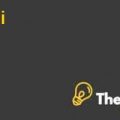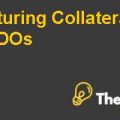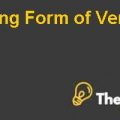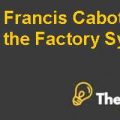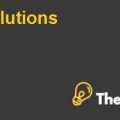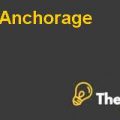
PASSING ON VS ABSORBING
The option that Fortis Industries hold against the increase price of raw material is to either increase its selling price or pass on the increased cost on the customers or the company could absorb the increased cost and operate at reduced margins keeping the cost constant.
If the company increases its selling price passing on the cost then evidently the customer is going to be on the receiving end and he would not be happy about it as now he would be paying additional cost for the same product, due to this the customer would resort to two options buy the product from other cheaper source or accept the price and buy it anyway even if he is not happy. There is a greater chance the company would lose sales because of this as it is being assumed other competitors are providing the same product on a lower price.
Similarly the sales force would become demotivated because if the price is increased it would make it more difficult for them to achieve their sales targets as the customer would not be motivated to buy the product now they would not only lose their bonuses but there is a chance they might lose their jobs if targets are not met.
The competitors usually follow whatever the leaders of the market are doing that is if Fortis increases its prices the competitors would also reduce their prices but in this scenario it seems like the competitor have increased their price on paper but are offering the same reduced price to the customer due to which the competitors are achieving the higher market share and Fortis is losing its share.
If this increased cost is absorbed by the company then it is more likely to keep its customers happy and its sales staff motivated this will not only prompt the customer to buy Fortis product due to the reduced price but would also give the staff a more then hopeful chance to achieve their targets and their bonuses but most importantly it will keep the company in a competitive position against the competitors.
INSTITUTING VS NON-INSTITUTING PRICE FLEX
The second option the company holds is to provide a price-flex, in this option the company would allow a discount on the premium price of up to 7% in order to stay competitive and to hold its market share. These discounts will be provided by the sales representatives and would be given to customers who are a more regular to the company and buy the product on a commodity bases whereas premium prices are going to be charged to service oriented customers. This would not only entice the customers to become regular but would also make them maintain good relations to be able to get the discounts, this strategy would make the customers happy especially the older customers.
The employees would find this as a very motivating move as this gives them an opportunity to compete for the sales in the market and have an edge over others this would enable them to achieve their bonuses which would ensure them the security of their jobs.
The competitors would find this move threatening as this would ensure Fortis maintains its market share and since it already is the market leader makes it very difficult for them to compete in the market.
PRICE INCREASE
|
Profit Drivers |
|||||
|
Apex |
BBM |
HDM |
Custom |
||
| Sales (Mio. $) |
114 |
92 |
115 |
22 |
|
| Operating Profit Margin Ratio (Return on Sales, ROS) |
27% |
24% |
26% |
26% |
|
| Raw Material Costs in % of Variable Costs |
83% |
79% |
90% |
84% |
|
| Other Variable Costs in % Variable Costs |
17% |
21% |
10% |
16% |
|
| Variable Costs in % of Total Costs |
88% |
84% |
86% |
86% |
|
| Total Variable Costs in % of Sales |
64% |
64% |
64% |
64% |
|
| Total Costs (Mio. $) |
83 |
70 |
85 |
17 |
|
| Fixed Costs (Mio. $) |
10 |
11 |
12 |
2 |
|
| Variable Costs (Mio. $) |
73 |
59 |
73 |
14 |
|
| Contribution Margin Ratio |
36% |
36% |
36% |
36% |
|
| Contribution Margin (Mio. $) |
41 |
33 |
41 |
8 |
|
| Operating Profit (Mio. $) |
31 |
22 |
30 |
6 |
|
| Break-even Sales (Mio. $) |
28 |
30 |
33 |
6 |
|
| Safety Coefficient in % of Sales |
75.07% |
67.14% |
71.54% |
71.58% |
|
|
Profit Driver Change |
Price |
Volume |
Raw Material Costs |
Variable Costs |
||||||
| Option 1: Business as usual (pass on steel price increase, no Price-Flex) |
6.0% |
0.0% |
6.8% |
5.7% |
||||||
| New Profit |
6% |
6.8% |
6% |
34 |
24 |
32 |
6 |
96 |
8 |
|
| Change in Profit |
6% |
6.8% |
6% |
9% |
10% |
9% |
9% |
9% |
||
| New Profit Margin Ratio (Return on Sales, ROS) |
6% |
6.8% |
6% |
28% |
25% |
27% |
27% |
28% |
||
| Change in Profit Margin Ratio (Return on Sales, ROS) |
6% |
6.8% |
6% |
2% |
3% |
3% |
3% |
9% |
||
| New Contribution Margin Ratio |
6% |
6.8% |
6% |
36% |
36% |
36% |
36% |
36% |
||
| Change in Contribution Margin Ratio |
6% |
6.8% |
6% |
0% |
0% |
0% |
0% |
0% |
||
There will be a need to increase the price by 6% to maintain the company’s to maintain the company’s original ....................
This is just a sample partial case solution. Please place the order on the website to order your own originally done case solution.

